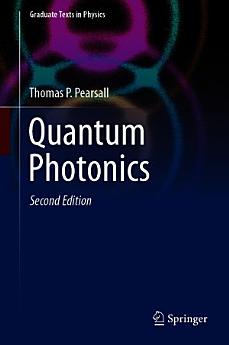Quantum Photonics: Edition 2
Thomas P. Pearsall
ene 2021 · Springer Nature
Libro electrónico
367
Páginas
reportLas calificaciones y opiniones no están verificadas. Más información
Acerca de este libro electrónico
Photonics is the discipline of electrons and photons working in tandem to create new physics, new devices and new applications. This textbook employs a pedagogical approach that facilitates access to the fundamentals of quantum photonics. Beginning with a review of the quantum properties of photons and electrons, the book then introduces the concept of their non-locality at the quantum level. It presents a determination of electronic band structure using the pseudopotential method, enabling the student to directly compute the band structures of most group IV, group III-V, and group II-VI semiconductors. The book devotes further in-depth discussion of second quantization of the electromagnetic field that describes spontaneous and stimulated emission of photons, quantum entanglement and introduces the topic of quantum cascade lasers, showing how electrons and photons interact in a quantum environment to create a practical photonic device.
This extended second edition includes a detailed description of the link between quantum photon states and the macroscopic electric field. It describes the particle qualities of quantum electrons via their unique operator algebra and distinguishable behavior from photons, and employs these fundamentals to describe the quantum point contact, which is the quantum analogue of a transistor and the basic building block of all nanoscopic circuits, such as electron interferometers.
Acerca del autor
Thomas Pearsall has a distinguished career in photonic science and technology, where he has made major contributions to fiber-optic telecommunications and silicon photonics. A graduate of Cornell University, he worked in research at Thomson/CSF, and at Bell Labs for nearly two decades. In 1990, Pearsall was named Boeing-Johnson Chair and Professor at the University of Washington. From 1998 to 2002, he directed research on planar photonic crystals at Corning in Fontainebleau, France. Throughout his career, he has invented and developed the semiconductor materials,l asers, LEDs and photodetectors that are ubiquitous in optical fiber telecommunication networks around the globe. He has also designed and demonstrated key elements of silicon-based photonics, using strained-silicon and silicon-based photonic crystal materials.
In 2003, Pearsall started EPIC, The European Photonics Industry Consortium, which has been a leading contributor to the launch and the development of the European Technology Platform Photonics21. He is a Fellow of the American Physical Society and a Fellow of the IEEE.
Califica este libro electrónico
Cuéntanos lo que piensas.
Información de lectura
Smartphones y tablets
Instala la app de Google Play Libros para Android y iPad/iPhone. Como se sincroniza de manera automática con tu cuenta, te permite leer en línea o sin conexión en cualquier lugar.
Laptops y computadoras
Para escuchar audiolibros adquiridos en Google Play, usa el navegador web de tu computadora.
Lectores electrónicos y otros dispositivos
Para leer en dispositivos de tinta electrónica, como los lectores de libros electrónicos Kobo, deberás descargar un archivo y transferirlo a tu dispositivo. Sigue las instrucciones detalladas que aparecen en el Centro de ayuda para transferir los archivos a lectores de libros electrónicos compatibles.





